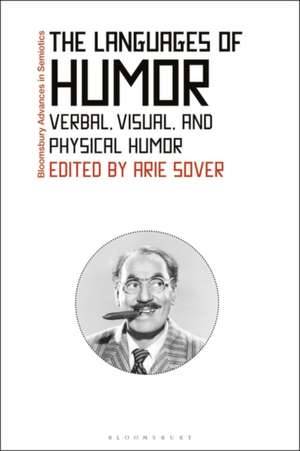The Languages of Humor: Verbal, Visual, and Physical Humor: Bloomsbury Advances in Semiotics
Editat de Professor Arie Soveren Limba Engleză Paperback – 18 mar 2020
| Toate formatele și edițiile | Preț | Express |
|---|---|---|
| Paperback (1) | 226.79 lei 6-8 săpt. | |
| Bloomsbury Publishing – 18 mar 2020 | 226.79 lei 6-8 săpt. | |
| Hardback (1) | 775.83 lei 6-8 săpt. | +153.57 lei 7-13 zile |
| Bloomsbury Publishing – 19 sep 2018 | 775.83 lei 6-8 săpt. | +153.57 lei 7-13 zile |
Din seria Bloomsbury Advances in Semiotics
- 14%
 Preț: 179.13 lei
Preț: 179.13 lei - 22%
 Preț: 271.40 lei
Preț: 271.40 lei - 22%
 Preț: 256.85 lei
Preț: 256.85 lei -
 Preț: 173.71 lei
Preț: 173.71 lei - 18%
 Preț: 238.84 lei
Preț: 238.84 lei - 30%
 Preț: 568.71 lei
Preț: 568.71 lei - 14%
 Preț: 171.77 lei
Preț: 171.77 lei - 14%
 Preț: 1006.79 lei
Preț: 1006.79 lei - 23%
 Preț: 190.96 lei
Preț: 190.96 lei - 23%
 Preț: 198.05 lei
Preț: 198.05 lei - 13%
 Preț: 231.16 lei
Preț: 231.16 lei -
 Preț: 198.22 lei
Preț: 198.22 lei - 13%
 Preț: 232.07 lei
Preț: 232.07 lei - 13%
 Preț: 237.28 lei
Preț: 237.28 lei - 13%
 Preț: 258.42 lei
Preț: 258.42 lei - 24%
 Preț: 190.16 lei
Preț: 190.16 lei - 8%
 Preț: 299.19 lei
Preț: 299.19 lei - 23%
 Preț: 192.30 lei
Preț: 192.30 lei - 18%
 Preț: 306.47 lei
Preț: 306.47 lei - 22%
 Preț: 257.32 lei
Preț: 257.32 lei - 22%
 Preț: 223.58 lei
Preț: 223.58 lei - 30%
 Preț: 773.39 lei
Preț: 773.39 lei - 22%
 Preț: 238.40 lei
Preț: 238.40 lei - 23%
 Preț: 192.73 lei
Preț: 192.73 lei - 22%
 Preț: 237.84 lei
Preț: 237.84 lei - 22%
 Preț: 1007.62 lei
Preț: 1007.62 lei - 8%
 Preț: 131.83 lei
Preț: 131.83 lei - 18%
 Preț: 305.53 lei
Preț: 305.53 lei
Preț: 226.79 lei
Preț vechi: 289.96 lei
-22% Nou
Puncte Express: 340
Preț estimativ în valută:
43.40€ • 45.14$ • 35.83£
43.40€ • 45.14$ • 35.83£
Carte tipărită la comandă
Livrare economică 12-26 aprilie
Preluare comenzi: 021 569.72.76
Specificații
ISBN-13: 9781350155268
ISBN-10: 1350155268
Pagini: 336
Ilustrații: 20 bw illus
Dimensiuni: 156 x 234 x 22 mm
Greutate: 0.47 kg
Editura: Bloomsbury Publishing
Colecția Bloomsbury Academic
Seria Bloomsbury Advances in Semiotics
Locul publicării:London, United Kingdom
ISBN-10: 1350155268
Pagini: 336
Ilustrații: 20 bw illus
Dimensiuni: 156 x 234 x 22 mm
Greutate: 0.47 kg
Editura: Bloomsbury Publishing
Colecția Bloomsbury Academic
Seria Bloomsbury Advances in Semiotics
Locul publicării:London, United Kingdom
Caracteristici
Features world-leading humor studies experts such as Arthur Asa Berger, Bob Mankoff (cartoonist and the Cartoon Editor for The New Yorker), and Eric Horvitz, Managing Director at Microsoft Research, USA
Notă biografică
Arie Sover is a Lecturer and Researcher in Communication and Humor Studies at the Open University of Israel, Israel. He is the author and editor of six books (including this one), and numerous articles on humor research. He is also the Founder and Chair of the Israeli Society for Humor Research, and the Founder and Editor of two scientific journals, Humor Mekuvan (in Hebrew), and the Israeli Journal of Humor Research: An International Journal.
Cuprins
IntroductionPart I: Jokes and Joking1. Jokes and Insults: Language and aggression (Christie Davies, University of Reading, UK)2. How Jokes Work?: Seven Humor Theorists in Search of a Joke (Arthur Asa Berger, San Francisco State University, USA)3. God, Jokes, Parnusseh & Tsores: Jewish Humor (Joseph Dorinson, Long Island University, USA)4. Holocaust Jokes on American and Israeli Situational Comedies: Signalling Positions of Memory Intimacy and Distance (Jeffrey Scott Demsky, San Bernardino Valley College, USA and Liat Steir-Livny, Sapir Academic College and the Open University of Israel, Israel) 5. Intertextuality and Cultural Literacy in Contemporary Political Jokes (Villy Tsakona, Democritus University of Thrace, Greece)6. Humor and Liminality: A Case Study of the Maltese Gahan (Mary Ann Cassar, University of Malta, Malta)7. Multifacet Pragmatics of Russian Post-Soviet Jokes (Kravchenko Nataliia, Kiev National Linguistic University, Ukraine, & Pasternak Tetiana Anatoliivna, National University of Life and Environmental Sciences of Ukraine, Ukraine)Part II: Caricatures and Cartoons8. Caricature as a Weapon in Class Struggle: Early Soviet Graphic Satire (Annie Gérin, Université du Québec à Montréal, Canada) 9. The Internet Political Meme: A remediation of the political cartoon (Khin-Wee Chen, University of Canterbury, New Zealand) 10. The Interplay Between Visual and Verbal Language in "Famous Last Words" Cartoons (Carla Canestrari) 11. Inside Jokes: Identifying Humorous Cartoon Captions Algorithmically (Dafna Shahaf, Hebrew University of Jerusalem, Israel, Bob Mankoff, Cartoon Editor for The New Yorker Magazine, USA & Eric Horvitz, Technical Fellow and Managing Director at Microsoft Research, USA) 12. Caricature as Desacralization of the Image: The Charlie Hebdo Case (Ayelet Lilti, Elie Wiesel Institute in Paris, France)Part III: Slapstick and Physical Comedy 13. Slapstick Comedy: Under What Conditions Can Body Movements be Humorous? (Paul Bouissac, University of Toronto, Canada) 14. Slapstick in the American Cinema: From Circus Clowns to the First Cinema Comedians (Arie Sover, Ashkelon Academic College and the Open University, Israel) 15. Slapstick Humor in Children's Popular Literature (Evangeline E. Nwokah, Vanessa Lopez & Erin Morrison, Our Lady of the Lake University, USA) 16. Shenanigans on Stage: Cultural Re-appropriation of Classical Music through Slapstick (Terri Toles Patkin, Eastern Connecticut State University, USA) 17. Consequential Slapstick: Staging the Aristophanic Slapstick in Lysistrata (Vicky Manteli, Hellenic Open University, Greece)BibliographyIndex















